Breaking Free: Why Direct Sales Might Be For You – Part Two
Last week, Ginger began a series on direct sales – the idea of selling a book directly to readers from your own website, instead of through one of the traditional online retailers.
Today we continue this discussion with part two, where Ginger walks us through his personal reasons for wanting to give the direct sales route a try. Through disclosure of some of his actual historical sales numbers, he provides context that may help others decide if selling direct is right for them. These numbers will also be useful to compare against in the future, when he takes us through how well his direct sales experiment actually went.
Last week, I started a series about how I’ve spent a month selling my books directly to readers on Facebook, rather than sending them to my product page on Amazon. The direct sales model isn’t for everyone though, so it will help to first give some context as to what led to my decision to finally give it a try. My journey may help you decide if selling direct is right for you, as well.
Why did I make the move?
I’ve been writing and publishing on Amazon since 2013, but it wasn’t until 2018 that I had my first best-seller. I went from making up to $50 a day from my books to suddenly making $500+ between royalties and Kindle Unlimited page reads. On my best day, I made $615 dollars.
This was a game-changer for me. I’d never realized it was possible to make this much money from writing before, and I definitely wanted more. I threw myself into writing and publishing following that initial success and was initially more than rewarded. I consistently made $10,000+ a month from my book sales on Amazon simply from publishing a new book every 60-90 days – with my best month exceeding $14,000 in royalties!
And the remarkable thing was all this was organic. Back in 2018, advertising on Amazon wasn’t an option, so all the recommendations and suggestions Amazon made were organic, based on the success of individual books. My books were successful, and therefore Amazon suggested them more often – meaning the better my books did, the better my other books did!
But in 2019 Amazon introduced advertising onto their platform. Now, instead of seeing purely organic suggestions from Amazon’s algorithm, customers would see paid-for ads sprinkled into their search results. As more and more of the real estate of each product page was allocated towards paid advertising, the impact of organic suggestions lessened. As a result, simply publishing new books every few months wasn’t enough to sustain an income that I could use to support my family.
And that’s been the struggle ever since. These days, the only way to make money through self-publishing is to market and advertise your books. However, as I explained last week, that isn’t always easy or sustainable. I was at an advantage because I’d worked in advertising for 20+ years, and I had a big series of romance books that people clearly wanted to read – but even then, it took a while to make any advertising profitable.
The biggest challenge was that Attribution Tags don’t necessarily track all of the sales or page reads that come from your advertising. One month when I was starting out, for example, my Attribution Tags tracked $252.82 in book royalties based on an advertising spend of $252.98. By that metric, I was a few cents short of breaking even.
However, I’d actually made $505.80 more in book sales and royalties than I had in the months that I hadn’t been advertising – and there had to be a correlation, since I’d never seen a random jump that high. So while the Attribution Tags told me I was making a loss, I was actually making nearly 100% profit on my advertising, according to the increase in actual sales.
And that’s the dream, right? To invest $1 in advertising and get $2 back? Most advertisers would be thrilled to be doubling their money every month.
But the problem is, it’s not possible to sustain a family on $505.80 every month (at least where I live) – so I needed to spend more; and that’s exactly what I did. The following month I spent $937.01 on advertising and saw an increase in sales of $1,117.27. Great, right?
Except that meant I’d only made $180.26 in profit that month – so instead of doubling my money, I’d just fallen short of a 20% profit. I mean, sure that was profit – but it’s frustrating to spend double the money and make half the return that you had the month before.
However, I continued to tweak and change things until the situation improved. Over the course of the next year, I spent $4,744.58 on advertising on Facebook. After paying that bill, I still earned an additional $4,868.25 in profit—money I wouldn’t have earned without any advertising. This meant that over the course of the year, my advertising efforts more than doubled my money. Great, right?
I mean, I certainly wasn’t complaining – but it was frustrating. The most frustrating part was the fact that Amazon didn’t pay me until 60 days after months end – so, for example, I didn’t get the money I’d spent in March back (plus my $180.26 profit) until the end of May. To keep my advertising going through that period, I had to lay down $2,700 in advertising costs right out of my own pocket, with the hope that I’d see all of it back again.
And that just wasn’t working for me.
The biggest problem was that I wasn’t in the financial situation to throw $2,700 around with casual indifference any longer – and when Amazon finally paid me, it only covered one of the months I’d been advertising. In my personal life, I needed to fix my car and pay for my son’s AP College Credit classes, so I ended up having to hustle like crazy to be able to pay my bills and keep advertising.
And that also meant I didn’t have any hope of scaling up – and that’s really where you either make it or break it as an author. Realistically, I wanted to make a full-time income from writing again, which meant I needed at least ten times more profit every month than I’d been making.
The challenge? I’d need ten times as much advertising money to make that happen. Stretching the budget to cover $2,700 was (barely) sustainable. Spending $27,000 over the next ninety days was a pipe-dream.
Of course, I could have made it happen. I could have squirreled away my profits, and waited until I’d finally saved enough to scale things up. The problem was that there was no guarantee things would work out; and losing $27,000 on failed advertising would have probably resulted in losing my wife, as well (she’d be out the door within seconds!)
Now, I don’t necessarily think that would have happened – losing all of that spend with nothing to show for it. My books have always consistently sold well, and I know how to advertise effectively. You need only go to the Top 100 books for your genre on Amazon to see writers who are clearly spending hundreds of dollars (at least) to get their books ranked highly, and when you’ve got that kind of budget, each dollar stretches that much further. You can absolutely make a killing advertising on Amazon…
…but only if it doesn’t kill you first.
Which is why I decided to try Direct Sales instead.
I’d heard various people talking about it for the last year or so, including Steve Pieper and the highly-regarded Joanna Penn. I had many hesitations about it – not to mention a certain amount of fear – but I also couldn’t help but be fascinated at the potential advantages. Eventually, in January of this year, I decided to take the plunge; and it’s been a wild ride since then.
Let me be clear, though. Selling direct is NOT as easy as just putting your books up on Amazon or any of the other online stores. There is significant setup involved, which is what I’ll focus on next week, in part three.











